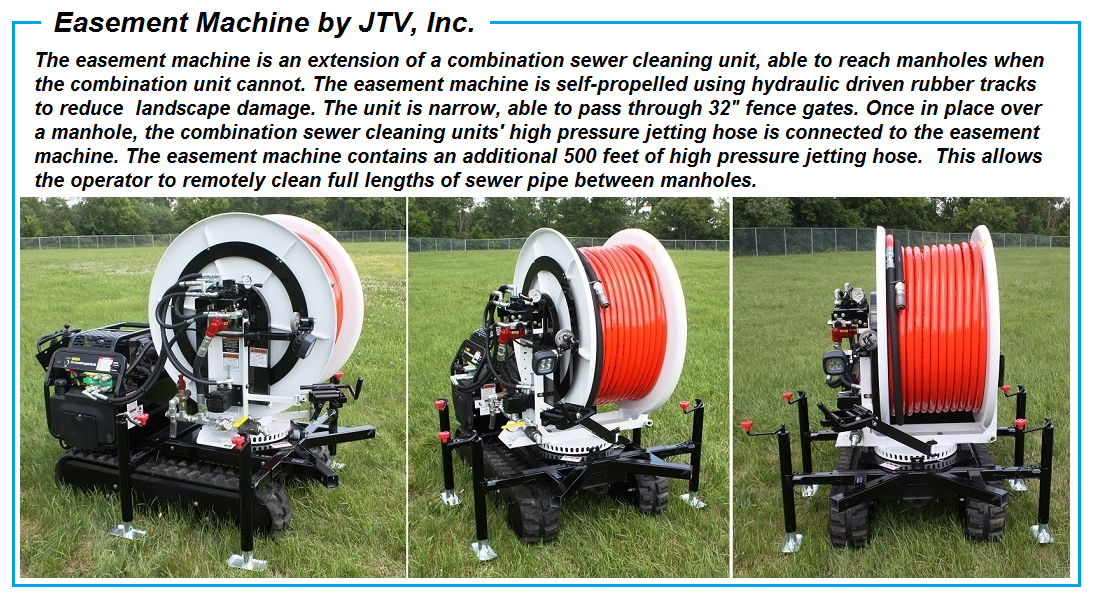Sewer Cleaning
Sanitary Sewer Cleaning - Sewer Jetting
All waste water sewer lines need periodic maintenance. Soap and grease buildup along with root infiltration can cause pipeline choking & eventual inconvenient blockages. Buried sewer lines cannot be viewed with an "out of sight, out of mind" attitude. Basic high pressure jetting of sewer lines and then followed with a sewer inspection by CCTV cameras give municipal officials an up to date, true indication of their collection system. JTV, Inc. operates multiple combination sewer cleaning units capable of jetting with pressures up to 2500 psi with flows of 120 gallons per minute. These combination units have vacuum capability, capable of vacuuming up debris through 8" diameter hoses into 12 cubic yard debris tanks. Debris vacuumed from sewers is transported to permitted facilities for proper disposal.

What is high pressure jetting?
High pressure jetting is using streams of high pressure water to clean, cut, and remove debris. The main components of a high pressure jet are the pump, engine, hose, and nozzle. The pump and engine work together to create high pressure water through the hose to the nozzle. The nozzle has small precision machined orifices that restrict the water flow, thus creating high pressure build up in the hose. Water shoots out of these orifices, and converts from pressure to velocity, and it is the speed of the water combined with the volume that does the cleaning work. The angle of the jets in the nozzle creates the forward propulsion to pull the nozzle up the pipe. Once extended up the pipe, the hose under pressure is retracted using a hydraulic powered hose reel to overcome the pulling force. While being retracted, the rear nozzle jets form a water curtain that cleans and washes debris away. Forward facing jets will clear and cut through debris, while rear facing jets flush debris back and propel the nozzle through the pipe. Rotating or spinning nozzles create a 360 degree cleaning action which is ideal for grease and root removal.
JTV, Inc. operates several different models of high pressure jetting units for different types of pipe cleaning jobs. Units range from 4,000 PSI at 18 gallons per minute to 2,500 PSI at 120 gallons per minute. A general rule for high pressure jetting units is "Pressure cuts, flow moves debris".

Concentrated Pipe Cleaning
During normal jetting of sewer lines, the nozzle may pass by root masses or heavy scale deposits and only partially remove the root mass. When these situations are discovered during a CCTV inspection, the high pressure jetting unit will be used to totally remove the root mass. The high pressure jetting unit will work from the downstream manhole and be guided by a CCTV inspection system operating from the upstream manhole. Using two-way radio communication, the jet nozzle is positioned directly at the root mass and multiple passes are made until the root is fully removed.
Removal of roots or a root blockage in a sewer line is only temporary as roots will regenerate. Root removal in a sewer line is similar to hedge trimming, a process that may require to be repeated every two to three years.
Pipe Cleaning Prior To The Installation Of A CIPP Liner
A clean pipe is critical for a successful installation of a cured-in-place pipe liner. Extra detailed must be used to remove all debris from the bottom of the pipe as well as removal of all roots. Failure to fully clean the pipe will result in "lumps" in the finished CIPP liner that is not acceptable. For pipes previously cleaned and televised the day before a CIPP liner installation, the process is always repeated just before the liner installation begins.


|
|